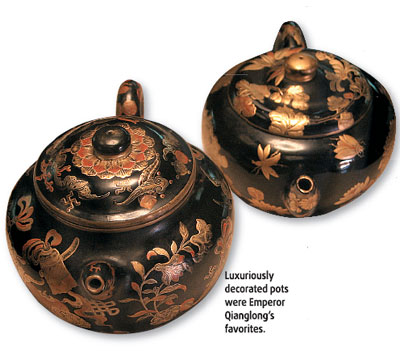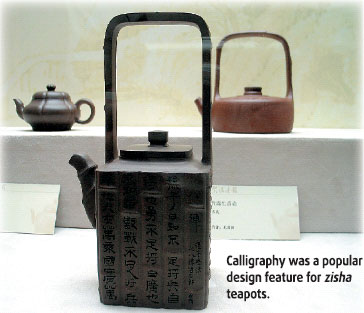 Inside the glass cabinet, a pair of melon shaped teapots lie on red velvet. The purple clay body is covered with a lacquer exterior, with gold tracery laced over the green background. The patterns of cloud, bird and flower are designed exquisitely, shining with a faint gloss.
Inside the glass cabinet, a pair of melon shaped teapots lie on red velvet. The purple clay body is covered with a lacquer exterior, with gold tracery laced over the green background. The patterns of cloud, bird and flower are designed exquisitely, shining with a faint gloss.
The pair of teapots, which is a precious court collection of the period of Qianlong Emperor (reign 1736-95) of the Qing Dynasty (1644-1911), is an exhibit of the ongoing zisha (purple clay) show being held at the Palace Museum located in the Forbidden City.
Besides tea sets, other imperial collection made of purple clay are also on show.
Accompanied by melodious Chinese ancient music and the special aroma emanating from the purple clay, the show gathers some 110 pieces of zisha teapots and other treasures carefully selected from the some 400 permanent collections of the museum.
The zisha ware, is a cultural emblem of Yixing, a ceramic center in East China's Jiangsu Province. (Zisha refered to the clay material used. Zi, in ancient Chinese language, also means dark brown.) The artifacts entered the imperial court as tributes by regional officials beginning from the Ming Dynasty (1368-1644). During the Qing Dynasty, especially the reign of Emperor Yongzheng (reign 1723-35) and Qianglong (reign 1736-95), the court placed many orders with Yixing for the interest of the emperors. The wonderful clay interpretations and usefulness of the Yixing wares made them favorites at the imperial court.
The exhibits include the imperial tea set collections and bamboo tea service chests from the Ming and early Qing dynasties, teapots made by famous craftsmen, as well as flower pots and ink slabs, brush holding jars and seals, all made of purple clay. Silk-screens, Chinese paintings, red sandalwood round tables and cabinets are also cultural relics chosen from the museum.
The shapes of the zisha teapots vary from round, square, tripod to broad-bottomed, with pattern designs of landscape, calligraphy, signature and poetry as well as fruit and lotus. Some of the exhibits are of original purple clay bodies and some are covered with lacquer exteriors or pale blue glaze.
The design of the spout conveys the consummate technique and rich imagination of the craftsmen. One object features a dragon head spout, suggesting the momentum of the ancient Chinese totem, while a broad-bottomed teapot is matched with a short and thin spout.
When it came to teapots, different emperors had different tastes. Emperor Qianglong was fond of luxurious decoration. Among the exhibits, a pair of teapots covered with black lacquer and gold tracery was one of his favorites. The teapots and canisters of his period were always decorated with his poems and paintings. Emperor Yongzheng loved natural colors of purple clay. Elegant in their simplicity, these tea wares represent the aesthetic of the Yixing items used in his royal court.
There is also a cabinet displaying raw minerals of purple clay and the tools used to make the teapots. Also a video showing how teapots being produced is played on a big screen.
Text by Wu Liping and photos by Jiang Dong
50 yuan. 8:30am-5pm, until Oct 31. Hall for Abstinence (Zhai Gong), Palace Museum, 4 Jingshan Qianjie, Dongcheng District. 8511-7575. 故宫博物院斋宫, 东城区景山前街4号
(China Daily 05/30/2007 page20)